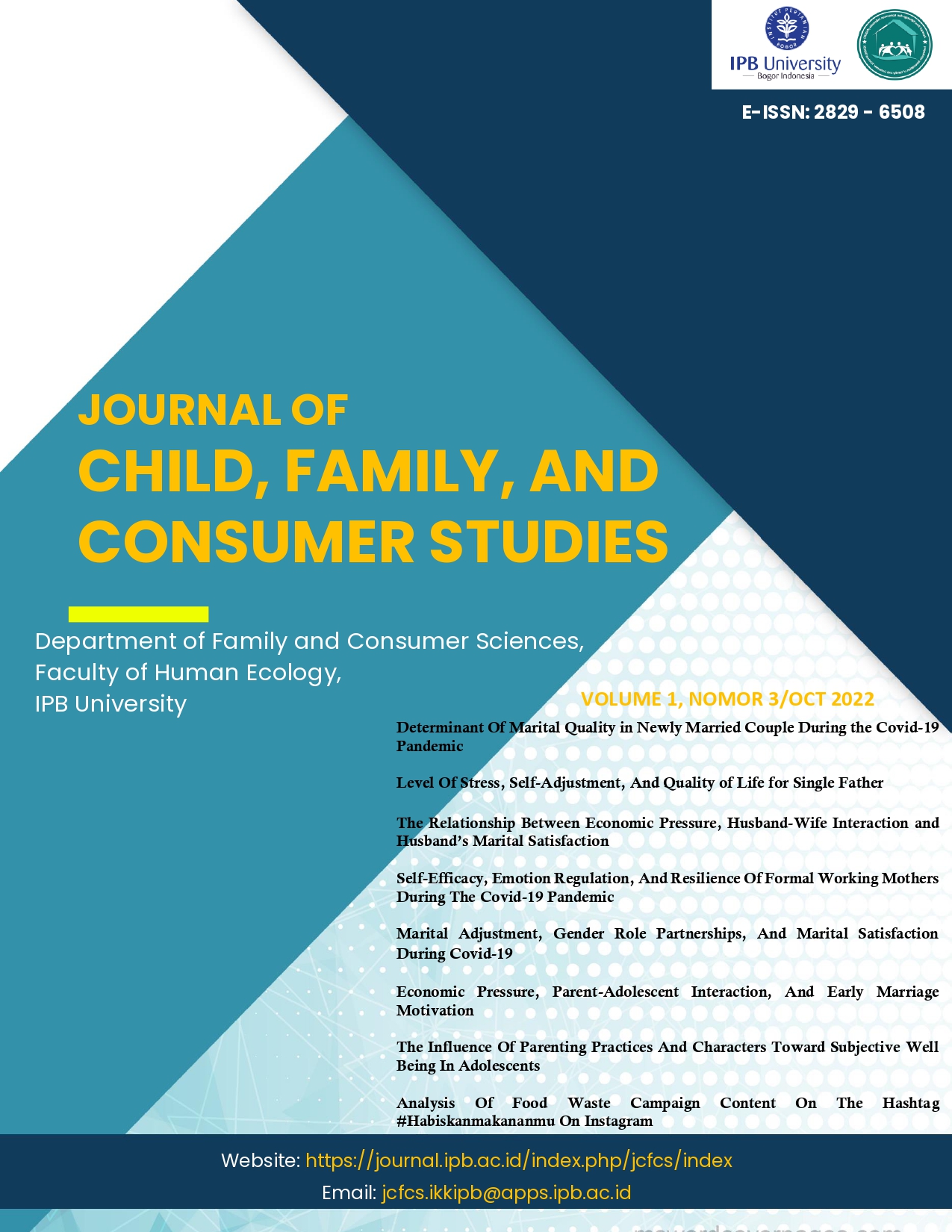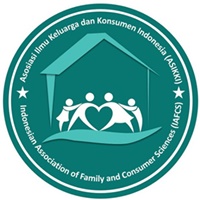MARITAL ADJUSTMENT, GENDER ROLE PARTNERSHIPS, AND MARITAL SATISFACTION DURING COVID-19
Abstrak
During the Covid-19 pandemic, orders to work and study from home became a problem for families in Indonesia. Marital adjustment and gender role partnerships in the household must be well established to create marital satisfaction so that there is no conflict in the family. This study analyzes the factors influencing marital satisfaction in intact families during the Covid-19 pandemic. Respondents in this study are wives from intact families who have children and are domiciled in the city of Bogor. The sampling technique used non-probability purposive sampling with several samples of as many as 128 people. The data was processed using descriptive and inferential tests and multiple linear regression using SPSS 25 and Structural Equation Modeling (SEM) using SmartPLS 3.0. The correlation test results showed a positive correlation between marital adjustment, gender role partnerships, and marital satisfaction. The results of the linear regression test showed that the husband's income had a significant positive effect on marital satisfaction. Correlation tests, linear regression test results, and SEM showed that marital adjustment and gender role partnerships significantly positively affected marital satisfaction. There is an indirect effect between marital adjustment and marital satisfaction with gender role partnership mediators.
Referensi
Anjani, C. (2006). Pola Penyesuaian Perkawinan Pada Periode Awal, 8(3), 198–210. url: http://repository.unair.ac.id/id/eprint/26593
Archuleta, K. L., Britt, S. L., Tonn, T. J., & Grable, J. E. (2011). Financial satisfaction and financial stressors in marital satisfaction. Psychological Reports, 108(2), 563–576. https://doi.org/10.2466/07.21.PR0.108.2.563-576
Ardhianita, I., & Andayani, B. (2005). Kepuasan pernikahan ditinjau dari berpacaran dan tidak berpacaran. Jurnal Psikologi, 32(2), 101–111. https://journal.ugm.ac.id/jpsi/article/view/7074
Azeez, A. (2013). Employed women and marital satisfaction: a study among females nurses. International Journal of Management and Social Sciences Research (IJMSSR), 2(11), 17–22.
Aziz, A., & Iman, N. (2017). Relasi gender dalam membentuk keluarga harmoni (Upaya membentuk keluarga Bahagia). HARKAT: Media Komunikasi Islam Tentang Gender Dan Anak, 12(2), 2017. https://doi.org/doi: 10.15408/harkat.v13i1.7713
Bentler, P. M., & Newcomb, M. D. (1978). Longitudinal Study of Marital Success and Failure. 46, 1053–1070.
Bharambe, K. D., & Baviskar, P. A. (2013). A study of marital adjustment about some psycho-socio. International Journal of Humanities and Social Science Invention, 2(6), 8–10.
[BKKBN] Badan Kependudukan dan Keluarga Berencana Nasional. (2020). Survei kondisi keluarga pada masa pandemi covid-19. Bkkbn.
Carli, L. L. (2020). Women, Gender equality and COVID-19. Gender in Management, 35(7–8), pp. 647–655. https://doi.org/10.1108/GM-07-2020-0236
Carlson, D., Petts, R., & Pepin, J. (2020). Changes in Parents’ Domestic Labor During the COVID-19 Pandemic. https://doi.org/10.31235/osf.io/jy8fn
Collins, C., Landivar, L. C., Ruppanner, L., & Scarborough, W. J. (2021). COVID-19 and the gender gap in work hours. Gender, Work and Organization, 28(S1), 101–112. https://doi.org/10.1111/gwao.12506
Dewi, E. M., & Basti, B. (2008). Konflik perkawinan dan model penyelesaian konflik pada pasangan suami istri. Jurnal Ilmiah Psikologi Gunadarma, 2(1), 98377.
Dowlatabadi, F. H., Saadat, S., & Jahangiri, S. (2016). The Relationship between Religious Attitudes and Marital Satisfaction among married personnel of departments of education in Rasht City, Iran. International Journal of Advanced Studies in Humanities and Social Science (IJASHSS), 5(2), 102–110.
Epifani, I., Wisyaningrum, S., & Ediati, A. (2021). Marital Distress and Satisfaction During the COVID-19 Pandemic: A Systematic Review. Proceedings of the International Conference on Psychological Studies (ICPSYCHE 2020), 530(Icpsyche 2020), 109–115. https://doi.org/10.2991/assehr.k.210423.016
Filsinger, E. E., & Wilson, M. R. (1984). Religiosity, socioeconomic rewards, and family development: predictors of marital adjustment. Journal of Marriage and the Family, 46(3), 663. https://doi.org/10.2307/352607
Fowers, B. J., & Olson, D. H. (1993). ENRICH Marital Satisfaction Scale: A Brief Research and Clinical Tool. Journal of Family Psychology, 7(2), 176–185. https://doi.org/10.1037/0893-3200.7.2.176
Hurlock, E. B. (2011). Psikologi perkembangan : suatu pendekatan sepanjang rentang kehidupan edisi kelima. In Jakarta : Erlangga (pp. 205–243).
Kerkmann, B. C., Lee, T. R., Lown, J. M., & Allgood, S. M. (2000). Financial management, financial problems and marital satisfaction among recently married university students. Journal of Financial Counseling and Planning, 11(2), 55–65.
Kodan Çetinkaya, S., & Gençdoğan, B. (2017). The relationship between marital quality, attitudes towards gender roles and life satisfaction among the married individuals. Psychology, Society, & Education, 6(2), 94. https://doi.org/10.25115/psye.v6i2.511
Krzaklewska, E. (2014). Working Paper No . 1 . 2 “ Gender Equality and Quality of Life – State of Art Report ” Measurement of Gender Equality – Analysing Dimensions , Embracing Areas , Considering Contexts Ewa Krzaklewska. 1, 1–33.
Larasati, A. (2012). Kepuasan perkawinan pada istri ditinjau dari keterlibatan suami dalam menghadapi tuntutan ekonomi dan pembagian peran dalam rumah tangga. Jurnal Psikologi Pendidikan Dan Perkembangan, 1(3), 1–6. http://www.journal.unair.ac.id/filerPDF/alpenia_ringkasancorel.pdf
Lee, W. S., & McKinnish, T. (2019). Locus of control and marital satisfaction: Couple perspectives using Australian data. Journal of Economic Psychology, 74(September), 102205. https://doi.org/10.1016/j.joep.2019.102205
Litzinger, S., & Gordon, K. C. (2005). Exploring relationships among communication, sexual satisfaction, and marital satisfaction. Journal of Sex and Marital Therapy, 31(5), 409–424. https://doi.org/10.1080/00926230591006719
Maharrani, A. (2021). Perceraian di Indonesia terus meningkat. [diakses 2021 Jun 15]. https://lokadata.id/artikel/perceraian-di-indonesia-terus-meningkat.
Maiti, T., & Innamuri, R. (2020). Marital distress during COVID-19 pandemic and lockdown : a brief narrative. International Journal of Indian Psychology, 8(2), 426–433. https://doi.org/10.25215/0802.257
Manyam, S. B., & Junior, V. Y. (2014). Marital Adjustment Trend in Asian Indian Families. Journal of Couple and Relationship Therapy, 13(2), 114–132. https://doi.org/10.1080/15332691.2013.852491
McDonald, J. E., Olson, J. R., Lanning, A. H., Goddard, H. W., & Marshall, J. P. (2018). Effects of Religiosity, Forgiveness, and Spousal Empathy on Marital Adjustment. Marriage and Family Review, 54(4), 393–416. https://doi.org/10.1080/01494929.2017.1403992
Megawangi, R. (1999). Membiarkan Berbeda? Sudut Pandang Terbaru Tentang Relasi Gender. Indonesia Heritage Foundation.
Moser, C. (1993). Gender Planning and Development: Theory, Practice, and Training. Routledge.
Pratiwi, H. (2016). Hubungan antara dukungan sosial keluarga dengan kepuasan perkawinan pada Istri. Calyptra, 5(1), 1–11.
Pusat Informasi & Koordinasi COVID-19: Provinsi Jawa Barat. (n.d.). https://pikobar.jabarprov.go.id/
Puspitawati, H. (2013). Pengantar Studi Keluarga. IPB Press.
Puspitawati, H. (2017). Gender dan Keluarga: Konsep dan Realita di Indonesia. IPB Press.
Puspitawati, H. (2020). Pengenalan dan Aplikasi Structural Equation Modelling (SEM) dalam Penelitian Ilmu Keluarga. Departemen Ilmu Keluarga dan Konsumen.
Puspitawati, H., Azizah, Y., Mulyana, A., Rahmah, A. F., Relations, G., Resilience, F., & Laborers, O. F. (2019). Relasi gender, ketahanan keluarga dan kualitas pernikahan pada keluarga nelayan dan buruh tani “Brondol” Bawang Merah. Jurnal Ilmu Keluarga Dan Konsumen, 12(1), 1–12. https://doi.org/DOI: http://dx.doi.org/10.24156/jikk.2019.12.1.1
Puspitawati, H., & Fahmi, S. A. (2008). Analisis pembagian peran gender pada keluarga petani. Jurnal Ilmu Keluarga Dan Konsumen, 1(2), 131–140. https://doi.org/10.24156/jikk.2008.1.2.131
Puspitawati, H., & Herawati, T. (2018). Metode Penelitian Keluarga (N. M. Dwi (Ed.)). IPB Press.
Putri, D. K., Krisnatuti, D., & Puspitawati, H. (2019). Kualitas hidup lansia: kaitannya dengan integritas diri, interaksi suami-istri, dan fungsi keluarga. Jurnal Ilmu Keluarga Dan Konsumen, 12(3), 181–193. https://doi.org/10.24156/jikk.2019.12.3.181
Qonitatin, N. (2012). Penyesuaian perkawinan dengan kecenderungan kesenjangan konsep peran suami istri. Fakultas Psikologi Universitas Dipoengoro.
Retiara, G. S., Khairani, M., & Yulandari, N. (2016). Asertivitas dan Penyesuaian Perkawinan pada Dewasa Awal di Aceh Tengah. Journal Psikogenesis, 4(2), 161. https://doi.org/10.24854/jps.v4i2.347
Saleha, Q., Hartoyo, H., & Hastuti, D. (2008). Manajemen sumberdaya keluarga: suatu analisis gender dalam kehidupan keluarga nelayan di Pesisir Bontang Kuala, Kalimantan Timur. Jurnal Ilmu Keluarga Dan Konsumen, 1(2), 118–130. https://doi.org/10.24156/jikk.2008.1.2.118
Septiana, V. S., Krisnatuti, D., & Simanjuntak, M. (2014). Faktor suku dalam pola komunikasi, penyesuaian suami istri, dan keharmonisan keluarga. Jurnal Ilmu Keluarga Dan Konsumen, 7(1), 1–9. http://journal.ipb.ac.id/index.php/jikk/article/view/9990
Sina, P. G. (2020). Ekonomi rumah tangga di era pandemi Covid-19. Journal of Management : Small and Medium Enterprises (SMEs), 12(2), 239–254. https://doi.org/10.35508/jom.v12i2.2697
Sorokowski, P., Randall, A. K., Groyecka, A., Frackowiak, T., Cantarero, K., Hilpert, P., Ahmadi, K., Alghraibeh, A. M., Aryeetey, R., Bertoni, A., Bettache, K., Blazejewska, M., Bodenmann, G., Bortolini, T. S., Bosc, C., Butovskaya, M., Castro, F. N., Cetinkaya, H., Cunha, D., … Sorokowska, A. (2017). Marital satisfaction, sex, age, marriage duration, religion, number of children, economic status, education, and collectivistic values: Data from 33 countries. Frontiers in Psychology, 8(JUL), 1–7. https://doi.org/10.3389/fpsyg.2017.01199
Spanier, G. B. (1976). Measuring dyadic adjustment: new scales for assessing the quality of marriage and similar dyads. Journal of Marriage and the Family, 38(1), 15. https://doi.org/10.2307/350547
Tavakol, Z., Nasrabadi, A. N., Behboodi, Z., 1, M., Salehiniya, H., Rezaei, E., & Moghadam, Z. B. (2017). A review of the factors associated with marital satisfaction. Galen Medical Journal, 6(3), 197–207. https://doi.org/10.22086/gmj.v0i0.641
Undang-Undang Republik Indonesia Nomor 52 Tahun 2009 tentang Perkembangan Kependudukan dan Pembangunan Keluarga. (n.d.). https://jdih.kemenpppa.go.id/peraturan/uu no 52 tahun 2009.pdf
Wulan, D. K., & Chotimah, K. (2017). Peran regulasi emosi dalam kepuasan pernikahan pada pasangan suami istri usia dewasa awal. Jurnal Ecopsy, 4(1), 58. https://doi.org/10.20527/ecopsy.v4i1.3417










